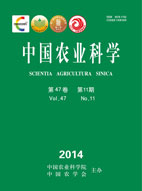-
Alleviation of Boron Toxicity on Rape Seedlings by Selenium
- DUAN Bi-Hui, LIU Xin-Wei, JIAO Wei, ZHAO Zhu-Qing, HU Cheng-Xiao
-
Scientia Agricultura Sinica. 2014, 47(11):
2126-2134.
doi:10.3864/j.issn.0578-1752.2014.11.006
-
 Abstract
(
592 )
Abstract
(
592 )
 HTML
(
2 )
HTML
(
2 )
 PDF (480KB)
(
693
)
PDF (480KB)
(
693
)
 Save
Save
-
References |
Related Articles |
Metrics
【Objective】 Boron (B) is an essential trace element for plant growth, however, excessive boron in soil may exert toxic effects on plants. In boron-deficiency soil, excessive use or uneven application of boron can easily lead to boron toxicity, if such levels of boron are accompanied by excessive salinity, the consequences can be drastic for plants. Boron toxicity is a significant constraint to cereal production in regions worldwide, including parts of southern Australia. Raising the suitable boron range of crops and reduce the toxicity of excessive boron are technical problems to be solved for agricultural production. An appropriate amount of selenium can improve crop resistance. This paper aims to investigate the effect of appropriate amount of selenium on rapeseed biomass and active oxygen metabolism under the condition of excessive boron, and explain the alleviation mechanism of selenium on boron inhabitation of rape growth. 【Method】In the present study, solution culture experiments were carried out using rape seedlings (Brassica napus L. cv. Xiangnongyou 571) as the test material. The interactive effects of boron and selenium especially with a purpose to test whether selenium application is effective in countering the boron toxicity were tested. Boron fertilizer was applied at two levels (50, 500 µmol?L-1), selenium fertilizer was applied at two levels (0, 1 µmol?L-1). The effects of these treatments on rape seedling growth, boron uptake and accumulation, enzymatic and non-enzymatic antioxidant, stress injury, oxidative damage along with defense mechanisms under boron (500 µmol?L-1) stress were assessed. 【Result】 Whilst boron application alone at 50 µmol?L-1 level was beneficial for the growth, treatment with boron severely inhibited the growth at 500 µmol?L-1 level. Under boron stress conditions, the dry weight of rapeseed seedling shoots and roots decreased significantly, rape seedling shoots and roots dry weight severely decreased by 20.1% and 32.0%, respectively, over 50 µmol?L-1 boron, and a lot of boron took up and accumulated over normal boron concentration (50 µmol?L-1). The enzymatic activity of scavenging reactive oxygen species, including catalase (CAT), peroxidase (POD) and ascorbate peroxidase (APX) in rape seedling leaves decreased, CAT, POD and APX activity decreased by 19.7%, 11.0% and 15.0%, respectively, compared to normal boron concentration, and the endogenous reactive oxygen substances (glutathione (GSH)) in leaves were significantly reduced, while hydrogen peroxide (H2O2) and malondialdehyde (MDA) increased significantly by 19.0% and 18.5% over 50 µmol?L-1 boron treatment. The boron-treated (500 µmol?L-1) plants supplemented with 1 µmol?L-1 selenium showed increased shoot and root dry weight, it significantly improved by 22.8% and 28.6% over boron-treated (500 µmol?L-1) plants, respectively, it also indicated that an antagonistic interaction between the two elements. Selenium at 1 µmol?L-1 concentration significantly affected the boron uptake and accumulation, it decreased boron content and accumulation in shoot by 38.6% and 31.9% respectively, over 500 µmol?L-1 boron treatment. Oxidative damage due to boron was lowered, which could be related to the reduction of active oxygen metabolism enzyme and endogenous scavengers in seedling leaves caused by boron toxicity were significantly alleviated. The boron-treated (500 µmol?L-1) plants supplemented with 1 µmol?L-1 selenium showed improved CAT, POD and APX activities, they increased by 12.8%, 15.1% and 15.3%, respectively, GSH and ASA contents increased by 9.7% and 21.0% over 500 µmol?L-1 boron treatment, while the accumulation of hydrogen peroxide and the increase of membrane lipid product malondialdehyde were effectively reduced, selenium application at 1µmol?L-1 to boron treated (500 µmol?L-1) plants, H2O2 and MDA content decreased by 25.1% and 22.1% over 500 µmol?L-1 boron treatment, respectively. 【Conclusion】 It was suggested that an appropriate amount of selenium can increase reactive oxygen metabolism of rapeseed and reduce the accumulation of reactive oxygen, thereby significantly decreasing the impact of excessive boron on rapeseed growth and improving the adaptability of rape seedlings to excessive boron.









